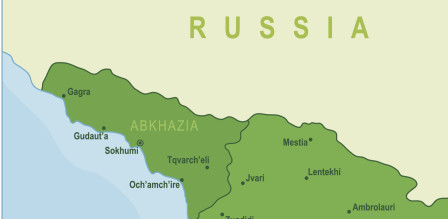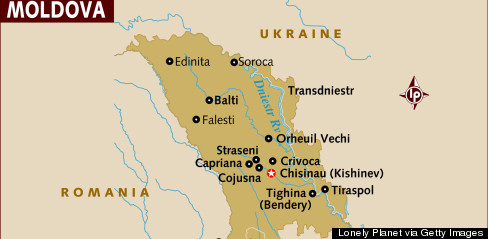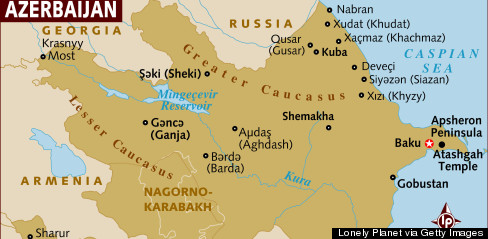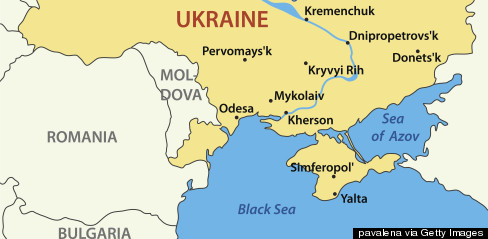
NATO's recent warning that Russia may be planning to use "the pretext of a humanitarian or peace-keeping mission" as a reason for invading Ukraine sounds ominous, but the fear is hardly unfounded. There are 20,000 Russian troops reportedly amassed along Ukraine's border, and there's a troublesome history of post-Soviet intervention by Russia into its former territories.
Since 1990 there have been no less than five Russian operations into neighboring states, either through direct military conflict (as seen in the 2008 conflict with Georgia), or through arms deals and tacit support of paramilitary groups (à la Ukraine). As Jeffrey Mankow argues in Foreign Affairs, the end result of these operations often has been the creation of a pro-Russian independent regions that practically no one recognizes except, well ... Russia.
While the world waits to see if Putin will indeed launch a full-scale invasion of Ukraine, potentially turning areas of the east into the next satellite under the Kremlin's influence, The WorldPost presents a brief history of Russia's post-Soviet land grabs. These are the places that make the map of the world look different to Russians.
1. South Ossetia
 Map shows South Ossetia, where Georgian troops fought Russians for control of the breakaway province in 2008. (Source: AP)
Map shows South Ossetia, where Georgian troops fought Russians for control of the breakaway province in 2008. (Source: AP)
The History: South Ossetia, a disputed region along the border between Georgia and Russia, was the scene of the most recent major standoff between the West and Russia. In the early 1990s, Ossetians fought for independence from Georgia, and for self-determination for their culturally and historically unique region; their failure to achieve independence set the scene for further tensions. The latest crisis came after Russia decided to launch an invasion of Georgia in August 2008, ostensibly as a humanitarian mission to protect Ossetians from Georgian aggression.
As Charles King explains in Foreign Affairs, there had actually been a Russian peacekeeping force in Georgian territory since the early '90s, in part to protect Ossetians but also to support their secessionist movement. When the Georgian government responded with force to Ossetian separatist attacks in August 2008, Russia launched a full-scale invasion in response.
The Result: The incursion was a diplomatic and humanitarian disaster. As King explains, it "killed hundreds, left thousands of refugees in temporary shelters, and brought relations between Russia and the United States to their lowest point since the dark days of the Cold War."
Facing increased international pressure, Russia ended the operation after five days of war, declaring South Ossetia an independent state.
Does Anyone Recognize It? Not really. As the New Republic reports, Russia is one of the only countries to recognize the region as legitimate, as do allies Venezuela, Nicaragua and the tiny south pacific island nation of Nauru.
2. Abkhazia
 Map of Georgia, showing Abkhazia. (Source: Getty)
Map of Georgia, showing Abkhazia. (Source: Getty)
The History: Much like South Ossetia, Abkhazia is an ethnic enclave that hosted a long-term Russian military presence, following a violent civil war in Georgia during the early '90s in which the Abkhaz people attempted to form their own state. As political scientist Kimberly Martin writes in The Washington Post, this U.N.-authorized Russian peacekeeping force began to show "disturbing signs of offensive activity as the years went by," priming the area for the conflict to come.
When violence in South Ossetia spurred Putin's 2008 intervention, Abkhazia was quickly brought into the fighting as well, with Russia "effectively using the region to open another front with Georgia," the BBC explains.
The Result: Abkhazia was declared an independent state (along with South Ossetia) in the aftermath of the Russo-Georgian conflict. How "independent" Abkhazia is remains questionable, as Russia controls its borders and has a deal to keep troops there for the next 45 years.
Does Anyone Recognize It? Abkhazia is only recognized by Russia, Venezuela, Nicaragua -- and, once again, Nauru.
(You might be wondering at this point what Nauru is and why it decided to join the others. Here's a detailed explanation, but the short answer is, it's an impoverished micro-state that needs money.)
3. Transnistria
 Map of Moldova. The region of Transnistria or Trans-Dniester falls along the border between Ukraine and Moldova.
Map of Moldova. The region of Transnistria or Trans-Dniester falls along the border between Ukraine and Moldova.
The History: Following the breakup of the Soviet Union, tensions arose between central Moldova and the linguistically, if not entirely ethnically, Russian region of Transnistria. War erupted between the central government and Transnistria after the region attempted to break away in 1990.
The Result: Hundreds died in the conflict, which was only resolved in 1992, when Russian troops "arrived and backed the separatists," as Shaun Turton explains in Slate.
Following a ceasefire, 1,500 Russian troops were stationed in the region, where they have been ever since. The disputed area remains in a tense but frozen situation, with Transnistria declaring itself as an independent state.
Does Anyone Recognize It? No. Not even Russia, despite a 2006 referendum in which 96 percent of the region voted that they wanted to become part of their patron nation.
4. Nagorno-Karabakh
 Map of Azerbaijan. (Source: Getty)
Map of Azerbaijan. (Source: Getty)
The History: Nestled in a disputed range of mountains between Azerbaijan and Armenia, Nagorno-Karabakh is a little different from the previous areas on this list, since it's not an independent state but actually a region that two nations claim. Ethnically Armenian, the region tried breaking away from Azerbaijan toward the end of the Soviet Union in 1988, resulting in regional war.
The Result: Years of war overtook Nagorno-Karabakh, with Russia indirectly supporting the secessionists through the backing of Armenia. But, as Brenda Shaffer writes in Foreign Affairs, "Moscow armed both sides and played them against each other."
After an estimated 30,000 people had been killed, Russia brokered a ceasefire in 1994. But The Guardian reports that intermittent fighting continues even today, and "dozens are killed in clashes along the line of control each year." This week saw some of the worst fighting since the ceasefire began, with the BBC reporting 15 killed in clashes.
Does Anyone Recognize It? This is slightly different than the others, since it is more a disputed zone than a region seeking complete autonomy, but essentially, no. Though opinions differ about who it belongs to, not even Armenia has chosen to recognize it as an independent state.
5. Crimea
 Map of Ukraine. (Source: Gettystock)
Map of Ukraine. (Source: Gettystock)
The History: Crimea, a peninsula off the Ukrainian mainland, is the latest site of a Russian incursion into neighboring states. Crimea was associated with Ukraine during the days of the USSR, and it formally voted to be a part of Ukraine in 1991 (albeit with only 54 percent of the population voting in favor).
The close referendum was a reflection of the fact that many Crimeans had closer ties to Russia than to Ukraine, something that would become important after the Ukrainian revolution overthrew Kiev's pro-Russian President Viktor Yanukovych. While unrest in Kiev grew, Russia took the opportunity to move heavily armed, masked troops into Crimea to annex the region.
The Result: Russian commandos quickly seized Crimea's bases, securing the peninsula under Russian control. As The Guardian states, U.S. officials recognized that Russia had “complete operational control of the Crimean peninsula,” and tried to diplomatically limit further incursions rather than attempt to retake the peninsula.
In March, Crimea voted to join Russia in a referendum marred by low turnout and condemnation of western leaders. Putin officially signed a treaty to absorb Crimea into Russia on March 18.
Does Anyone Recognize It? Not really. As Joshua Keating notes in Slate, the only countries that have thus far outwardly supported Russia's designation of Crimea are Syria and Venezuela. Not exactly a dream team, and something that gives an idea of who would be in line to support Russia if Putin decides to fully invade eastern Ukraine.
